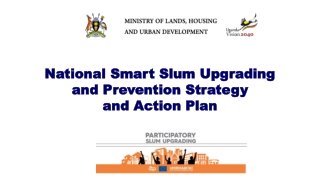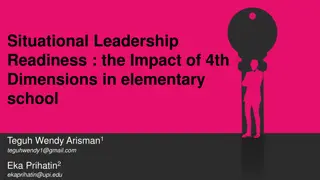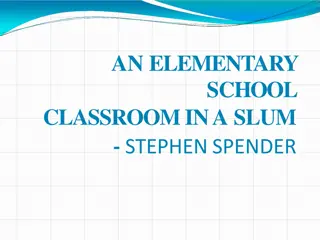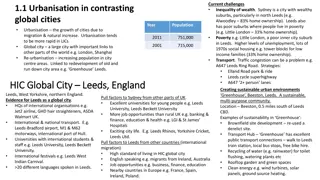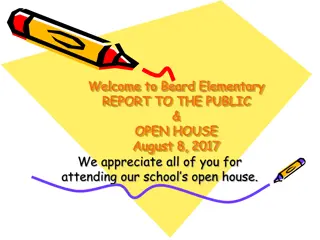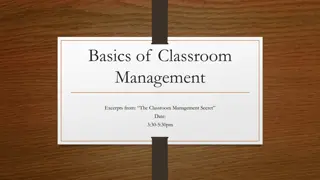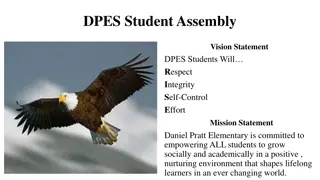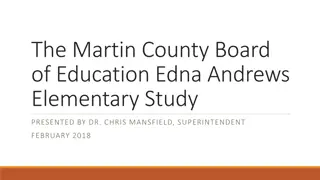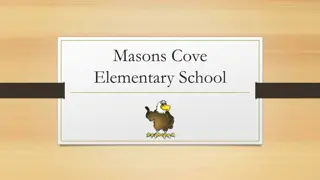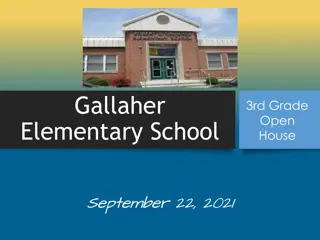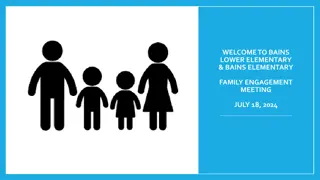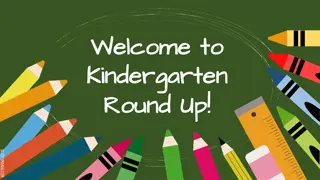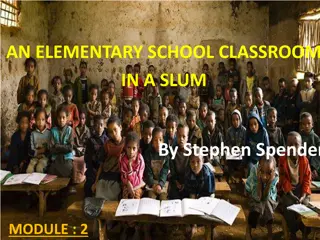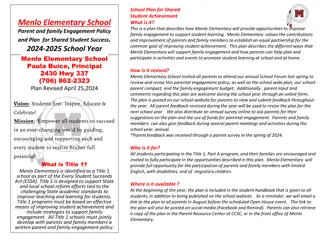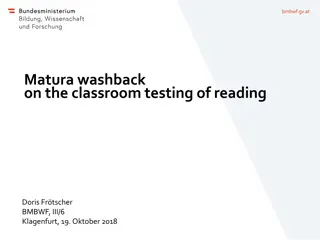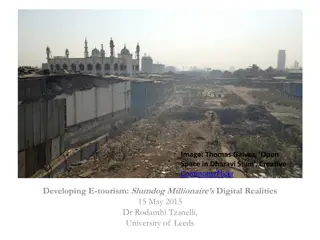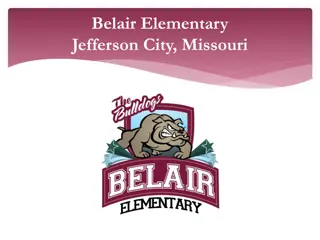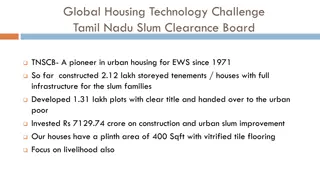
Critical Analysis of Educational Injustice in Spender's Poetry
Explore the theme of educational injustice in Stephen Spender's poetry, portraying underprivileged, malnourished students in a slum classroom. The poem critiques the limitations of a capitalist government in providing equal opportunities for education, reflecting on racial issues during the Civil Rights movement in the USA. Spender's political voice challenges social injustice and advocates for change in the education system.
Download Presentation

Please find below an Image/Link to download the presentation.
The content on the website is provided AS IS for your information and personal use only. It may not be sold, licensed, or shared on other websites without obtaining consent from the author. If you encounter any issues during the download, it is possible that the publisher has removed the file from their server.
You are allowed to download the files provided on this website for personal or commercial use, subject to the condition that they are used lawfully. All files are the property of their respective owners.
The content on the website is provided AS IS for your information and personal use only. It may not be sold, licensed, or shared on other websites without obtaining consent from the author.
E N D
Presentation Transcript
Stanza 1 1. Far far from gusty waves these children's faces. 2. Like rootless weeds, the hair torn around their pallor. 3. The tall girl with her weighed-down head. The paper- 4. seeming boy, with rat's eyes. The stunted, unlucky heir 5. Of twisted bones, reciting a father's gnarled disease, 6. His lesson from his desk. At back of the dim class 7. One unnoted, sweet and young. His eyes live in a dream, 8. Of squirrel's game, in the tree room, other than this.
Stanza 2 9. On sour cream walls, donations. Shakespeare's head, 10. Cloudless at dawn, civilized dome riding all cities. 11. Belled, flowery, Tyrolese valley. Open-handed map 12. Awarding the world its world. And yet, for these 13. Children, these windows, not this world, are world, 14. Where all their future's painted with a fog, 15. A narrow street sealed in with a lead sky, 16. Far far from rivers, capes, and stars of words.
Stanza 3 17. Surely, Shakespeare is wicked, and the map a bad example 18. With ships and sun and love tempting them to steal 19. For lives that slyly turn in their cramped holes 20. From fog to endless night? On their slag heap, these children 21. Wear skins peeped through by bones and spectacles of steel 22. With mended glass, like bottle bits on stones. 23. All of their time and space are foggy slum. 24. So blot their maps with slums as big as doom.
Stanza 4 25. Unless, governor, teacher, inspector, visitor, 26. This map becomes their window and these windows 27. That shut upon their lives like catacombs, 28. Break O break open 'till they break the town 29. And show the children green fields and make their world 30. Run azure on gold sands, and let their tongues 31. Run naked into books, the white and green leaves open 32. History is theirs whose language is the sun.
General Analysis Spender s political voice Ideological position on: Government Economics education
General Analysis The students in the classroom are: Underprivileged malnourished
General Analysis The capitalistic government is supposed to supply equal opportunity for education but the classroom in the slum offers little hope for change or progress for its lower-class students
General Analysis Written during the Civil Rights movement in the USA. Comments on race issues in American Education It is against capitalism and social injustice
General Analysis Poem is universal It does not mention: Country Location Race Citizenship
General Analysis Spender wanted to shed light on social injustices worldwide.
The Theme Stephen Spender highlights the plight of slum children by using vivid images and apt words to picture a classroom in a slum. Through this he touches, in a subtle manner, the themes of social injustice and inequalities
1. Far far from gusty waves these children's faces. 2. Like rootless weeds, the hair torn around their pallor. The line should state: These children s faces are far removed from looking like gusty waves Gusty waves: (image) shows brightness, verve and animation. It is missing from the slum children s faces.
1. Far far from gusty waves these children's faces. 2.Like rootless weeds, the hair torn around their pallor. Simile: Like rootless weeds Weeds show the children are unwanted Rootless shows they belong nowhere. The slum children are like rootless weeds , unwanted by society and not belonging to society.
1. Far far from gusty waves these children's faces. 2. Like rootless weeds, the hair torn around their pallor. Torn: uncombed hair Pallor : pale faces Their uncombed hair fall on their pale faces
A few of the slum children are being described: 1. The tall girl with her weighed-down head. 2. The paper-seeming boy, with rat's eyes. The stunted, unlucky heir Of twisted bones, reciting a father's gnarled disease, His lesson from his desk. 3. At back of the dim class One unnoted, sweet and young. His eyes live in a dream, Of squirrel's game, in the tree room, other than this.
A few of the slum children are being described: The tall girl with her weighed-down head. The tall girl s head is weighed-down with sadness, disinterestedness or shame or a mixture of all three. Tall over aged for class
A few of the slum children are being described: 1. The paper-seeming boy, with rat's eyes. The stunted, unlucky heir Of twisted bones, reciting a father's gnarled disease, His lesson from his desk. Metaphor: paper- seeming. The boy is as thin as paper. Rat s eyes: His eyes pop out from his thin body, looking furtive (sly) like rat s eyes.
A few of the slum children are being described: 1. The paper-seeming boy, with rat's eyes. The stunted, unlucky heir Of twisted bones, reciting a father's gnarled disease, His lesson from his desk. The stunted: he must have stopped growing Unlucky Heir:Inheritor (as if being poor is not enough he inherits this disease) Twisted bones: twisted growth
A few of the slum children are being described: reciting a father's gnarled disease, His lesson from his desk. The boy is not reciting a lesson from his desk, but he recites (shows) his disease from his desk. Gnarled: twisted, bent , knotty
A few of the slum children are being described: At back of the dim class One unnoted, sweet and young. His eyes live in a dream, Of squirrel's game, in the tree room, other than this. Right at the back of the badly lit room is an unnoticed young boy. He is probably too young for poverty to have stifled his childish imagination. He daydreams of the squirrel s game and about the tree house, absent mentally from the classroom
9. 10. 11. 12. On sour cream walls, donations. Shakespeare's head, Cloudless at dawn, civilized dome riding all cities. Belled, flowery, Tyrolese valley. Open-handed map Awarding the world its world You find: 1. Shakespeare s head 2. Clear sky at dawn 3. A beautiful Tyrolese valley 4. The dome of an ancient city building 5. A world map Metaphor: sour cream walls the walls are as awful as sour cream: old, derelict, rundown, ruins Donations: there are many things that have been donated on the walls.
The map gives the You find: 1. Shakespeare s head 2. Clear sky at dawn 3. A beautiful Tyrolese valley 4. The dome of an ancient city building 5. A world map Refers to knowledge, education, learning, culture and sophistication comes up. children live in. children A nature scene from the Alps. It shows hope and contrasts with world to In Contrast to the slum is the clear sky as the sun the slum the for civilization and progress the The dome of an ancient city building stands
The lines Open-handed map / Awarding the world its world could refer to the map of the world hanging on the wall of the classroom giving/showing (awarding) everyone (the world) the world out there to explore and know (its world).
Lines 13 to 16 World of slum children Not what map promises Windows of classroom Limited world
Future Foggy Bleak Dull
Their life/world : is confined within the narrow streets of the slum enclosed by the dull sky far away from rivers, seas that indicate adventure and learning and from the stars that stand for words that can empower their future.
'Lead sky' means a dull sky or a dimly lit sky. This symbolises the bleak, dull life and future of the slum children.
Lines 17 to 24 The poet feels that the head of Shakespeare and the map are cruel temptations for these children living in cramped houses (holes), whose lives revolve around (slyly turns) dullness (fog) and hopelessness (endless night) as they imagine and long for (steal) adventure (ships), for a better future (sun) and for love.
Their compared to slag (waste) heaped together seemed to be wearing the clothes of skin covering their peeping bones and wearing spectacles of steel with cracked glasses looking like bottle bits mended. emaciated wasted bodies
The slum is their map as big as the doom of the city buildings and their life (time and space) foggy and dim. The poet repeatedly uses the word fog to talk about the unclear, vague and dull life of the slum children.
The only hope of a life beyond the slums that enclose their lives like catacombs is some initiative by the governor, inspector of schools or a visitor. The poem ends with the poet fervently hoping that slum children will have access to better education and a better way of life.
He uses the words Break o break open to say that they have to break out from the miserable hopeless life of the slum world so that they can wander beyond the slums and their town on to the green fields and golden sands (indicating the unlimited world).
These can become their teacher and like dogs lapping up food hungrily, they can learn directly (run naked) from the open pages (leaves) of nature and the world which is sustained (whose language) by the sun standing for energy and life.

